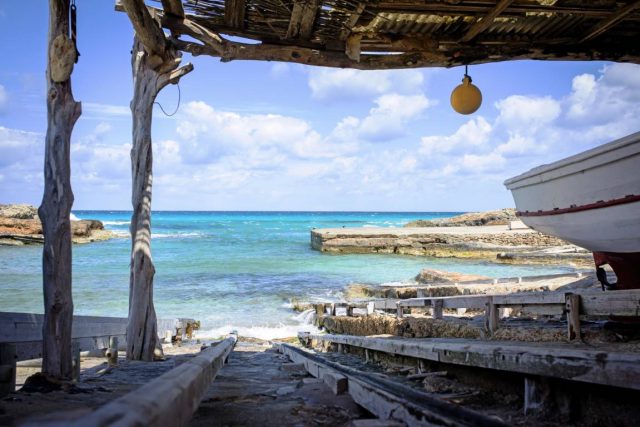
From picturesque stretches of golden sand to historic landmarks, the Balearic Islands are dotted with picture-perfect sights and breathtaking landscapes. Despite being one of Europe’s most popular summer holiday destinations, the islands of Mallorca, Menorca, Ibiza and Formentera offer many undisturbed, hidden gems to be discovered by visitors this summer.
Explore the island of Cabrera, a national park off the coast of Mallorca
Cabrera is an uninhabited island which floats ten miles off the coast of Mallorca and is one of the Balearic archipelago’s best kept secrets. In recent years, a number of its heritage and natural sites, such as the Cabrera Castle, have been restored thanks to the income from Sustainable Tourism Tax. The island’s landscape has remained unchanged for centuries, making Cabrera home to an abundance of seabirds, rich marine life and indigenous flora and fauna, and since 1991 it has been recognised as a National Park. Must-do activities when visiting Cabrera include diving or snorkelling which allow visitors to explore the biodiversity underneath the water’s surface including turtles, cuttlefish and over 500 other species.
There is a boat service running every day during the summer season which allows visitors to reach Cabrera from Colonia de Sant Jordi, located in Las Salinas (Ses Salines) in the south of Mallorca. The island also has a refuge for those who wish to stay there overnight with a limited capacity of four rooms for a maximum of 12 people.
Try mouthwatering local cuisine on the blissful beaches of Formentera
Dangling off the south coast of Ibiza, a mere half-hour away by fast ferry, the 20km-long island of Formentera is somewhat left out from the collective conscience of Britons when thinking of the Balearics. The picture-postcard island treats visitors to pristine, Caribbean style beaches and panoramic views over the islands beautiful and preserved nature which all contribute to its secluded charm.
Due to its isolation, Formentera’s gastronomy is based almost exclusively on slow-food cuisine and organic produce. The island’s bohemian vibe and deeply rooted sustainable agricultural traditions have given rise to a great variety of local delicacies and flavourful dishes, such as ‘peix sec’ (dried salted fish), ‘bullit de peix’ (a fish stew with potatoes), ‘flaó’ (cheesecake with a hint of mint) and several locally produced herbal liqueurs.
Lively beach bars, cafes and restaurants, such as the modern ChezzGerdi, can be found in the area of Es Pujols. To help visitors savour the best of Formentera, the island’s tourism board has launched a new slow food map, highlighting its traditional cuisine, local products and distinct flavours.
Discover the authentic charm of Ibiza in its hidden villages
Besides its bohemian vibe and picturesque beaches, Ibiza is also known for its charming villages with characteristic whitewashed buildings. Many of the island’s traditional lime-coloured farmhouses have been turned into stylish rustic hotels and retreats (known as agroturismos) allowing their visitors to enjoy the island’s tranquil and natural surroundings.
Nestled in the north of the island, Sant Joan de Labritja is one of the White Island’s hidden gems. Surrounded by pine tree-covered hills, this quiet Ibizan village is a sleepy rural haven. Thanks to its slow pace of life, tiny bars and cafes and a charming village square, Sant Joan de Labritja is often referred to as ‘the last real village in Ibiza’. While landmarks such as the whitewashed 18th-century church looms large over the village, modern establishments like The Giri Cafe make it an essential must-see when visiting Ibiza.
Find the medieval treasures in the heart of Palma de Mallorca
Besides being home to iconic monuments such as the ‘Le Seu’ cathedral, Palma de Mallorca hides a number of treasures right under the noses of visitors. These medieval streets are adorned with gargoyles, arches, rose windows in gothic churches, secluded squares and the famous Mallorcan patios.
There are more than 40 patios in Palma and each of the Mallorcan patios of Palma’s stately homes makes up a unique architectural space with its own aesthetic, identity and character. The origins of Palma’s patios go back to the Roman period however many were rejuvenated in the Renaissance and Baroque periods.
Many of the patios are located in private properties and can only be viewed from the outside in however there are a number that have become public institutions such as the Museum of Contemporary Spanish Art, the Palau March Museum or San Pere I San Bernat Hospital. Today visitors can stroll through Palma’s ancient streets discovering different patios and the history behind them. Tourist guide company Tomir offers professional walking tours for visitors interested in Palma’s cultural heritage, including the routes around the city’s historical patios (‘rutas de patios’).
Enjoy an abundance of Menorcan sea life in secret diving spots
Home to an abundance of winding coastal paths and rugged coves, the varied landscape and dramatic scenery of Menorca makes it a prime adventure destination. From the iconic Camí de Cavalls trail which circles the island, to lesser-known coastal paths, the island’s numerous paths allow visitors to explore even the most hidden corners of Menorca, such as Cala Rafalet.
Hidden at the end of a rustic trail and nestled on the island’s eastern coast, this uniquely narrow cove offers crystalline waters perfect for snorkelling, allowing keen divers to enjoy a sumptuous array of Menorcan sea life. Due to its size, Cala Rafalet can only allow few people at a time but watersports fans can enjoy an array of other activities offered in the local S’Algar area, including diving in the Isla del Aire marine reserve.





